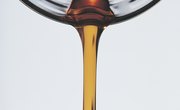
Viscosity and buoyancy are two factors which affect fluids, such as liquids and gases. At first glance, the terms appear to be very similar, as both appear to make a fluid resist any object which passes through it. This is in fact untrue, as both terms actually refer to very specific forces exerted either outwardly or inwardly. Variations in both factors cause liquids and gases to behave very differently.
Buoyancy
Buoyancy refers to the specifically upward force exerted by a liquid or gas on an object immersed in it. This is the chief force that allows an object to float. However, a floating object must displace a greater mass of water than the mass of itself in order to float. Otherwise, the upward buoyant force will not be great enough to prevent it from sinking. This is related to the density of the water; for example, if the water is more dense, a heavier object will have to displace less of it to stay afloat because the water will have a greater mass.
Viscosity
Viscosity is simply defined as the resistance of a liquid or gas to flow. The less inclined the gas or liquid is to flow, then the more viscous it is. Viscosity in liquids and gases is caused by their molecular makeup; very viscous liquids or gases have molecular makeups that cause a great deal of internal friction when they move. This friction naturally resists flow. Liquids and gases with low internal friction will flow very easily. Viscosity is different to buoyancy in that it describes internal forces within a substance, rather than an upward force exerted by a substance on another substance.
Floating and Sinking
While both factors of buoyancy and viscosity will allow an object to float for a limited amount of time, viscosity is not effective in keeping an object afloat indefinitely. When an object enters a liquid, the liquid it displaces is forced to flow downward to either side, making way for the object. In an extremely viscous liquid, this flow will be greatly decelerated, meaning the object may sit on top of the "displaced" liquid for sometime before sinking. However, even though friction decelerates internal movement, this movement is still taking place slowly but surely and the object will eventually sink if viscosity alone is a factor.
Effect of Heat
The application of heat also affects buoyancy and viscosity differently. Heating a viscous substance will decrease its viscosity as the molecules within gain more energy and are able to overcome the internal friction more easily. The effect that heat has on buoyancy, however, is dependant on what sort of liquid or gas is being heated. Generally, heating a liquid decreases its density, decreasing its potential to exert buoyant force because the mass of displaced fluid per volume decreases. However, some liquids, including water, can increase in density when heated slightly. Water is most dense at 39.2 degrees Fahrenheit, so heating water from 38 Fahrenheit to 39 Fahrenheit will actually increase it potential for buoyant force.
References
About the Author
Julia Salgado has been writing professionally since 2007. Her work has been published by the "Manchester Evening News" and "Q Magazine." Salgado holds a Bachelor of Arts in English from Manchester Metropolitan University.
